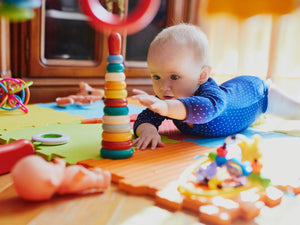Key Points
- One-sided breastfeeding is common, especially among newborns
- Preferences can result from factors like milk volume and personal comfort
- While it may impact breast appearance, babies tend to regulate their feeding
- Encouraging both breasts involves trying different positions, feeding environments, and patience
Feeding on one breast
One sided breastfeeding is not uncommon, particularly for newborns and when babies are almost ready to stop breastfeeding. This has a lot to do with the volume of milk they obtain from one breast and simply developing a preference for one side over the other.
But is one sided feeding a problem and should you be trying to encourage your baby to feed from both breasts? Read on to find out more.
Why does my baby only want one side when they feed?
There is a range of reasons why some babies just prefer to feed on one breast. Sometimes it’s unclear why a baby refuses to accept both breasts and prefers single sided breastfeeding.
Not every reason for refusal applies to every baby, every time which is one of the modules covered in our Newborn Feeding Guide.
10 of the most common reasons why babies may prefer one sided breastfeeding:- Their appetite is satisfied by feeding on one breast.
- For unknown reasons. Sometimes a baby will prefer one breast to the other and there is no obvious reason.
- They are more comfortable feeding on one side. They seem to prefer being positioned on one side than the other.
- The refused breast may not be producing as much milk, or the milk may not be flowing as fast as the preferred breast.
- Previous breast surgery which has changed the breast function.
- Recurrent mastitis and/or blocked milk ducts.
- There may be a change to the taste of the mother’s milk due to hormonal influence e.g., pregnancy, starting the oral contraceptive pill. The baby then becomes generally sensitive to breastfeeding and shows a preference for one breast over the other.
- Some mothers simply feel more comfortable holding their baby on a particular side. They report feeling ‘awkward’ when feeding on the other breast. This can be influenced by the mother’s dominant arm and hand.
- The baby simply refuses to latch on one side and this eventually has an effect on milk supply.
- Breastfeeding on a particular breast causes pain (mastalgia) for the mother. Although there may be no obvious reason for this, the discomfort is enough to not persevere with offering both breasts.
Am I creating a supply problem if my baby only wants to feed from one breast?
The principle of successful breastfeeding is that supply equals demand. If there’s a long break between breastfeeds and only one breast being stimulated, there is a potential for the milk supply to drop in that breast.
In the early newborn period, hormones have a major influence on breast milk supply. Over time, it is the baby’s (effective) sucking and regular feeding which helps to maintain supply.
Follow your baby’s lead and feed them when they’re showing hunger cues.

Help! My baby’s only feeding on one side now
You cannot control your baby’s feeding behaviour. In fact, one of the main differences between breast and bottle feeding is that breastfed babies regulate their own intake of milk. Your role is to offer breastfeeds when your baby is showing hunger cues. Whether they want to suck and how they suck is really up to them.
What you can try to persuade your baby to accept both breasts
- Try offering the least favoured breast first, at the start of your baby’s feeds when they are most hungry.
- You could start the feed by lying down if you usually sit up. If you usually lie down to breastfeed, try sitting in a chair. Some women start the feed by standing up and gently rocking and soothing their baby until they are latched on. Once the baby is sucking effectively, sit down. Just be careful your baby doesn’t always expect you to stand during feeds – this is exhausting and unsustainable for most mothers, especially as their baby gets heavier.
- Start the feed by feeding on the preferred breast and once you’ve let down, gently slide your baby over to the other breast.
- Feed your baby in a distraction free space where they stay calm and focused.
- Consider waiting a while between feeds so your baby is really hungry and more likely to feed on either breast.
- If your baby is aged over six months and eating solids, cut back on the amount of food you’re offering so they’re hungrier for breast milk.
- Offer the least favoured breast when your baby is sleepy and wanting to comfort suck.
- Only offer the least favoured side and express their preferred breast to maintain your supply. Once your baby is accepting the (previously) rejected breast, re-introduce both breasts with feeds.
- Hold and position your baby in a similar way as you do when they’re feeding on the preferred side.
- Be calm, reassuring and patient. Your baby’s feeding behaviours will change along with their development and periods of growth.
Will my breasts look lopsided if my baby is only feeding on one side?
The short answer is yes. Lactation tissue generally causes the breasts to expand to look and feel bigger. But this shouldn’t be noticeable to other people. Once you’ve stopped breastfeeding your breasts should be much the same size. Most women have one breast bigger than the other anyway.
If you’re still keen to lactate in both breasts and your baby is refusing to feed on both sides, express the breast they’re refusing. You can then offer the expressed breast milk (EBM) from a cup or a bottle. Doing this will help to equalise the size and shape of your breasts and lactating breast tissue.

For more information
Check with your Child Health Nurse or a lactation consultant to see if there’s anything else you can try.
Make sure your baby is growing and developing well. One sided feeding can impact on weight gain if a baby isn’t getting sufficient milk feeding on one side.
Written for Nourish Baby by Jane Barry, Midwife and Child Health Nurse.
Jane Barry is a registered nurse, midwife, and child health nurse with a passion for combining clinical expertise and writing. She has nearly 30 years of specialist experience in child health nursing and holds a Bachelor's Degree in Applied Science (Nursing). Jane specialises in women’s health, parenting, pregnancy, babies and maternity care, child health, nutrition, feeding, teething, and dental health issues.An active member of AHPRA, The Australasian Medical Writer’s Association, Health Writer Hub, and the Australian College of Children and Young People’s Nurses, Jane Barry delivers health content with professionalism and clarity.
References:
Breastfeeding while pregnant | Pregnancy Birth and Baby (pregnancybirthbaby.org.au)
One sided breastfeeding | Australian Breastfeeding Association
Our Products
-

01. Guide to a Healthy Pregnancy
$55 -

02. Positive Birthing Course
$55 -

03. Infant Feeding Guide
$55 -

04. Baby Sleep Guide - First 12 Months
$55 -

05. Toddler Parenting Course 1 - 3 Years
$55
-
 When to Start Antenatal Classes?
When to Start Antenatal Classes?
Becoming a parent is an incredible milestone, but it comes with a host of changes that can be daunting, especially for first time parents. Antenatal classes are all about offering expectant parents the education they need to make informed decisions, look after their bodies and care for their newborn babies. While you probably already have a long list of things you need to accomplish during your pregnancy, it’s a good idea to make time to attend antenatal classes.
-
 Development Milestones 4-8 Months
Development Milestones 4-8 Months
As they reach the middle of their first year, you'll start to see bigger leaps in their growth and ability!
In this article, we’re going to discuss your baby’s developmental milestones between 4-8 months, and what you can expect along the way.






 When to Start Antenatal Classes?
When to Start Antenatal Classes?
 Development Milestones 4-8 Months
Development Milestones 4-8 Months








